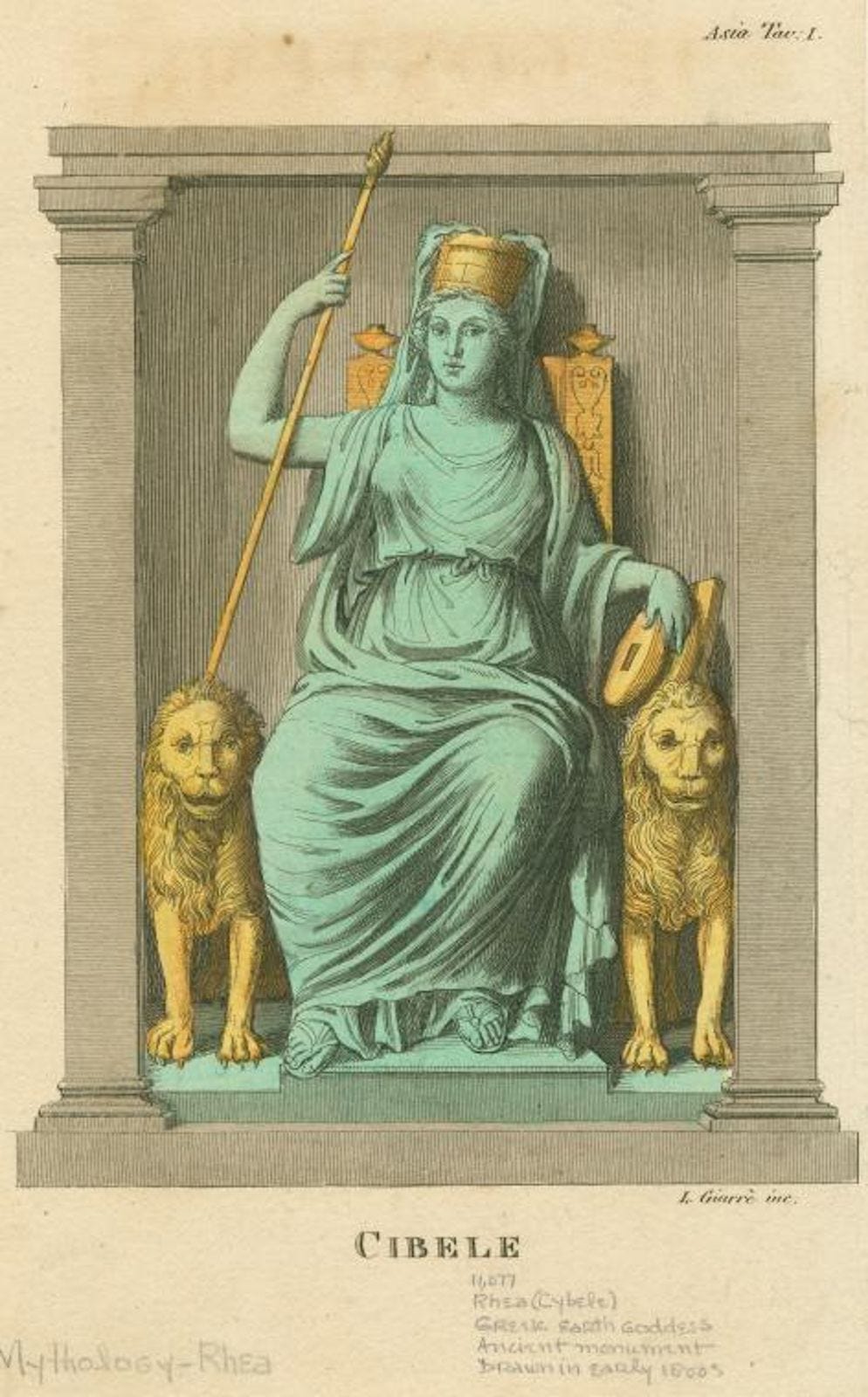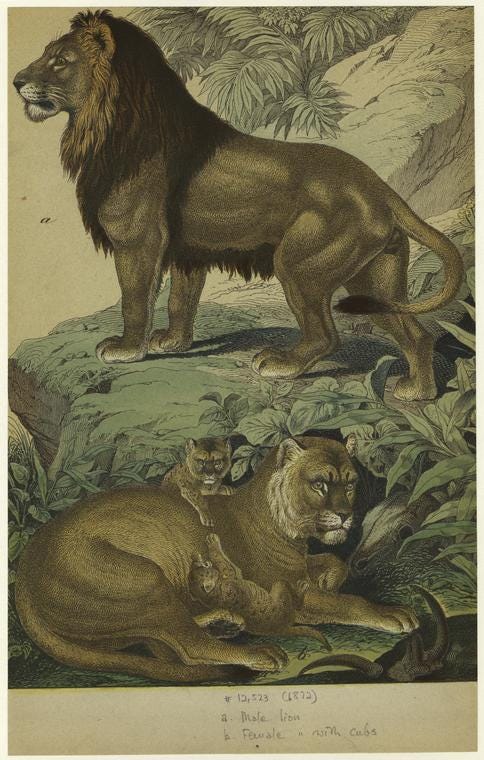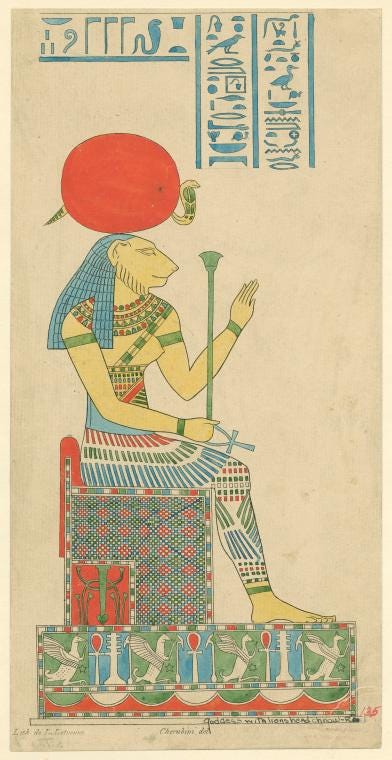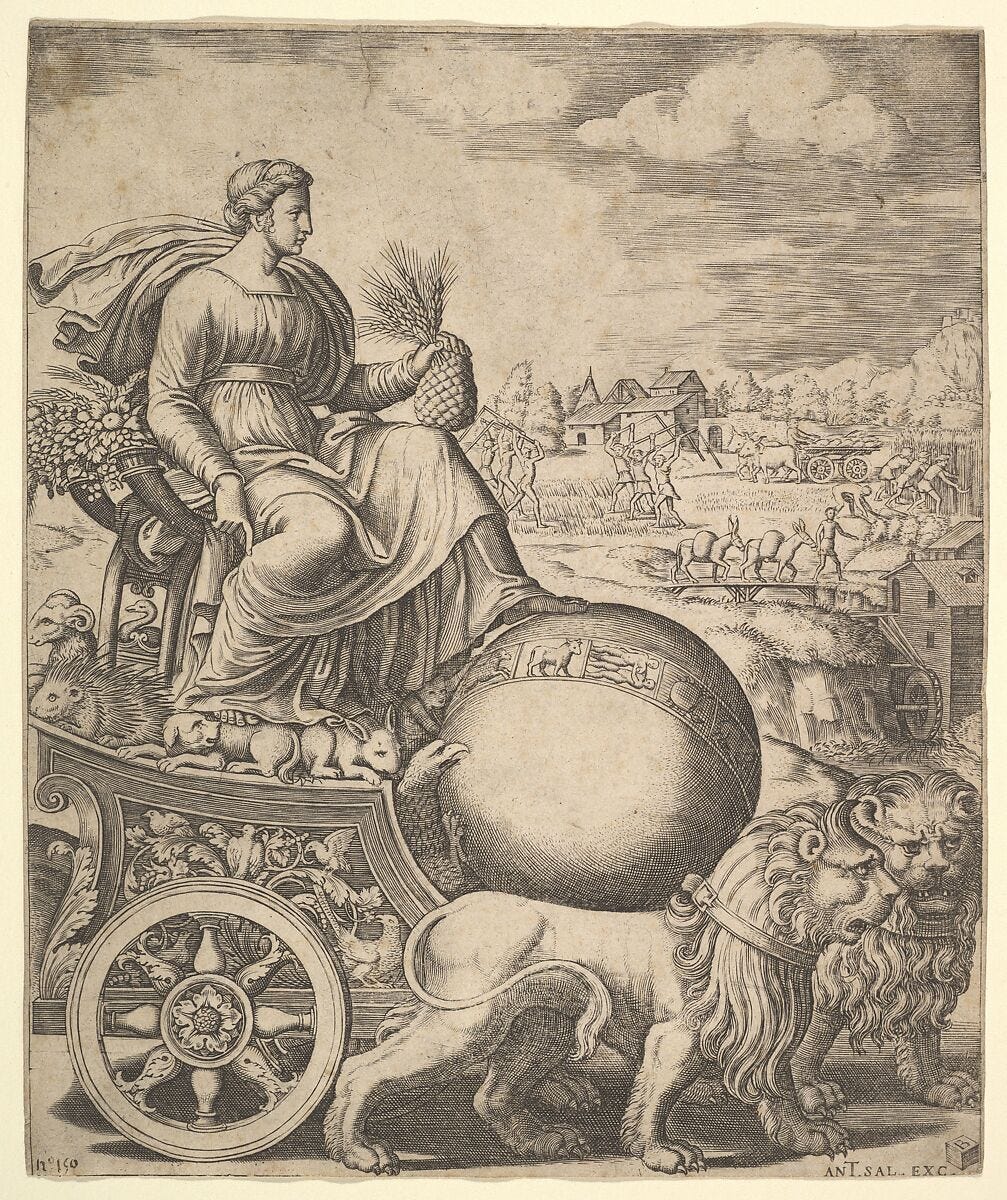The Changer: On the Fixed Star Denebola
exploring power from the margins, lordship over animals and trans priestesses

“Hate your enemies
Save your friends
Find your place
Speak the truth.”
Kurt Cobain
Today’s newsletter is a deep dive on the fixed star Denebola, found in the tail of the Leo constellation. You don’t need to have much technical knowledge of astrology to appreciate the stars. We have been writing stories and praying to them since we have been looking up. This essay is meant to help readers connect more deeply to these divine messengers and better understand ourselves. If you want to know if Denebola touches your chart, see if you have any planets or significant placements within 2º of 21º Virgo. Even if not, you have so much to learn from this fierce, transformative star.
If you want to learn more about how the stars touch and guide your beautiful life, and what your soul is asking of you, book a fixed star reading with me ⭐. You have to feel the magic of the stars yourself to believe it.
In the early 90’s you would be hard-pressed to find a more famous and miserable man than Kurt Cobain. With the smash hit of “Smells Like Teen Spirit” and its attending album, Nevermind, Nirvana, and its frontman, Cobain, were the biggest band in the world until Cobain’ss untimely death in 1994. Yet any who witnessed Cobain onstage or in interviews could see his relationship to success was ambivalent at best.
Kurt Cobain’s, and, by extension, his band Nirvana’s, public narrative can be summed up by this push and pull between fame and infamy; adoration of the masses and hatred of the attending scrutiny. In his time, as journalist Niko Stratis writes, “Cobain was still considered less an enigma than a petulant force. By his own words, he was pissy and ungovernable with the press, often picked on for his appearance, attitude, and demeanor”.1 Part of this is due to the disaffected, bombastic music he wrote, but this petulance predated his art. Stratis says that the first thing that struck her about Cobain was his anger:
I always felt that Cobain, like myself and indeed a lot of people, was vainly attempting to pinpoint the things within himself that felt out of step with the world around him. He wasn’t angry at a system or a woman who had wronged him. He was frustrated, seeking an unattainable sense of control over himself, his own pain, and his place in the world (emphasis mine).2
Kurt embodied both the anger of the harmed, as we see with his explicit solidarity with women, queers and people of color; as well as the all-too-human anger of a being who never felt completely at home in this world, or, at the very least, the one our consensus society has laid out.
Not only does Kurt Cobain have the fixed star Denebola in paran to his extremely powerful Venus3, but he was born with his ascendant conjoining this star, his place of life ever-entwined with the star in the tail of the Leo constellation. This star’s meaning is often in relation to its co-presence with Regulus, the heart of the Lion. As a royal star, Regulus is the pinnacle of military power, centralized leadership and the burdens of public scrutiny. But while Regulus governs from the center of the Lion, Denebola dangles from the end of the animal, ever-attached, but flicking this way and that.
In this essay, I will explore some the characters and monuments you may meet in the terrain of Denebola’s satellite city of misfits, warriors, iconoclasts and priestesses. Kurt will continue to be our companion and I will often reference his quotes or lyrics to show how different parts of the Denebola archetype have shone through his life. May this spread deeper communion with this star ⭐

The Reluctant Ruler
“I really miss being able to blend in with people."
Kurt Cobain
The name “Denebola” comes from “Al Dhanab al Asad,” meaning “the Lion’s Tail”; to the Greeks, the star was known as Alkaia, meaning ‘Mallow’.4 Other names for Denebola include "Dafira," which refers specifically to the coarse hair as the end of the lion's tail.5
Though Denebola’s relationship to power is different than that of Regulus, it is nonetheless associated with rulership across cultures. In Chinese astrology, Denebola is one of five stars known as “Woo Ti Tso”, or the Seat of the Five Emperors who are centered among hordes of officers and other nobles of the empire.6 In Vedic astrology, Denebola is the indicator star for the 10th Lunar Mansion, Uttara Phalguni, which Barbara Pijan calls the "curriculum of confident celebrity learning path of brilliant performance".7 In alignment with the Lunar Mansion's Solar themes, she also highlights Uttara Phalguni's "ability to shine their healing light on those with whom they come into contact".8 Typically, this mansion was considered "favorable for coronations, expiatory ceremonies," moments of kingship, as well as "planting of trees, sowing of seeds, building of towns, and matters of a permanent nature," all things which typically spring from stable leadership.9 Like other Leonine stars, Denebola can and does draw a crowd or gain power— but not without caveats.
Denebola is also known to bring misfortune, and portend disgrace— perhaps a sour ending to the coronation?— “and thus opposed to Regulus in character as in position in the figure,” as the website Constellation of Words puts it.10 While Regulus connotes classic imminence and conquering power, Denebola represents a different facet of power.
We can see this oppositional yet interconnected relationship between Denebola and power in the Egyptian Goddess Sekmet, the earliest known use of the lion symbol. She is a woman with the head of a Lionness, a precursor to the Sphinx, who had a Lion’s body, eagle wings and the head of a woman. Sekmet was the daughter of Ra, the Sun god, and was known for her “wrathful destruction” and her role as “an active aggressor against her father's enemies”.11 She was her father's right hand woman. Not only was she known as "lady of Flame" or "great lady, holy one, powerful one," she used fire to smite her enemy or flaming darts to hit them from a distance.
Her power is unmistakable but she is not without her sorrows. In one myth, her father, disgusted by humanity and their inability follow his divine laws, orders her to kill them all. Part of the way through, Ra gets cold feet, and unable to interrupt her wrathful destruction directly, he dyes jugs of beer with pomegranate juice, which Sekmet laps up, believing it to be blood. The alcohol causes her to slumber for three days and when she awakes her bloodlust is gone.12 Even when we "follow the rules" we see that power is fickle and often cruel. Just as Sekmet is syncretized with the scorching heat of midday, having all eyes on you can be like a magnifying glass, scrutinizing without really seeing while also burning you to death.
Denebola may bring potential for centrality and leadership but not without having to deal with its pitfalls and strictures. Those with prominent Denebola placements may find public attention or power a burden or prison, just as Cobain clearly did. But the lion’s tail is not just about the rejection or exclusion from that power, as is the case with Zosma, another star in the Leo constellation, but its subversion or redirection.
The Charismatic Heretic
I like to infiltrate the mechanics of a system by posing as one of them, then slowly start the rot from the inside of the empire.
Kurt Cobain
Vivian Robson associates a host of traits with this star: “swift judgment, despair, regrets, public disgrace, misfortune from the elements of nature, and happiness turned to anger, and makes its natives noble, daring, self-controlled, generous and busy with other people’s affairs”.13 Elspeth Ebertin sees this star as the the "cause of exciting events" while Barbara Pijan says those born under its Lunar Mansion are "[u]sually separated completely from the rest of the family.14 On the one hand, one sees the presence of star power with Denebola: nobility, bravery mixed with restraint, generosity, as well as the ability to spur flashy events into motion. On the other, there is great potential for infamy, "public disgrace," alienation and a souring of the initial high of fame with this star.
Over and over we see an ambivalent relationship to power with Denebola natives that cannot be relieved simply by avoiding it entirely. Bernadette Brady sees a compromise in finding authority in decentralized ways. Success is often promised with this star but “generally this success will be on the edge of the establishment, out of step with the main point of view… More simply, you could find that you hold opinions different from others, which causes frustration”.15 I will briefly point out that this phrase— "out of step,"— is the same one Stratis used to describe Cobain in her essay. Denebola natives face great pain from not fitting into the prefab boxes our world presents to us but that is also where their strength lies— smack within their own red-hot, undefinable chaos.

Change’s Pyre
“She'll come back as fire to burn all the liars
Leave a blanket of ash on the ground”
Kurt Cobain
According to Al Biruni, Uttaraphalguni, Denebola's station, was associated with great scientific advancement and is prominent in the charts of many ground-breaking scientists.16 Outside of scientific fields, this quality would translate to innovation or new ways of creating, connecting, being. The Arabic version of the lunar mansions, known as the manazil, calls Denebola's station Al Sarfah, “the Changer,” referring to its electional power to change the weather. Al Biruni states that “The heat turns away when [the mansion] rises, and the cold turns away when it disappears”. 17 Not only is Denebola known for dealing in contradictions— turning hot into cold and back again— but its version of change evokes meteorological metaphors; the power of storms and scorching heat to force great change.
No wonder, then, that the Lion’s is also said to give power over animals, another facet of nature’s raw power. Barbara Pijan tells us that making an appropriate offering to Aryaman, the deity of Denebola’s Lunar station, gives the devotee lordship over the animals.18 In his recount of the Leo constellation, Manilius draws heavily from the bestial qualities of the Lion:
"The lion ever devises fresh fights and fresh warfare on animals, and lives on spoil and pillaging of flocks...There are those whose like bent is not checked by the city-gates, but they swagger about in the heart of the capital with droves of beasts; they display mangled limbs at the shop-front, slaughter to meet the demands of luxury, and count it gain to kill" (emphasis mine).19
Not only are those influenced by this star "not checked by the city-gates," or untamed by civilizing influence, they bring the wildness of war and bloodshed to the heart of the capital. Diana Rosenburg tells us that "“[t]he Lion’s tail can ash with rage, bigotry and violence,”20 but we also see the presence of destruction when great change comes too. In the Arabic tradition, Denebola's mansion was used for the separation of people or lovers.21 In Kurt's case, we see this show up in his lyrics. Even ostensible love songs like "Heart-shaped Box" and " Drain You" contains lines like "It is now my duty to completely drain you"and "I've been locked inside your heart-shaped box for weeks" highlighting the violent passion often inherent to love and how its transformation comes with some sort of violent severing or loss. Every change is a loss, even if we choose it.
Because Denebola’s passion is not merely destructive but transmuting. The Euphrateans knew this star as “The Flaming One,” bringing to mind the purifying power of fire. Things that have been burned up cannot be brought back to their prior state, but they are still related to what they were before, while still being changed.
Leonine Feminine
“Never met a wise man/ if so it’s a woman”
Kurt Cobain
Of course in Christian theology, the first woman was created from transmutation; God made Eve from Adam’s rib. Throughout history, women are often seen as variation of men, who are the default. Perhaps that’s why goddess worship, long associated with the Nemean Lion, the beast Hercules slayed on Hera’s orders, has often been relegated to the margins or driven underground throughout history while male deities are given their pantheon.
Echoing the Egyptian Sekmet, old British coins used to depict a lion led by a woman, which the Romans imported to Britain after conquest.22 This symbol echoes the zodiac, as Leo the Lion precedes Virgo the Virgin; together they represent sovereignty.23 Part of Denebola's connection to being "out of step" is that valuing or worshipping the feminine over the masculine puts you at odds with predominating cultural forces.24 And while that may not be your exact preferred interest, don't be surprised if your chosen path is one that takes you outside centralized modes of power.
Kurt Cobain is an excellent example of this counter-cultural impulse. What always struck me as I started seriously getting into his music was how often he considered not just the feminine perspective but all sorts of marginalized groups. His song, “Been a Son,” lists all the reasons a parent is upset they had a daughter, sensitively highlighting the impossible pressures put on women from the moment they are born. In the liner notes for Nirvana’s 1992 album, Incesticide, he tells his fans: “If any of you in any way hate homosexuals, people of different color, or women, please do this one favor for us - leave us the fuck alone! Don't come to our shows and don't buy our records”.25 Here we see the wrath of Denebola intentionally turning away part of his fan base— another rejection of centralized power.
But Kurt didn’t simply abandon his manhood and only focus on women— he expanded what the former could mean. According to Niko Stratis, Cobain originally envisioned Nevermind as having a “girl side” and a “boy side”: “Songs like “Polly” (boy) and “Lithium” (girl) would have found their place on either side of the binary”.26 It's worth noting that Kurt seemed to have an ambivalent relationship to his own gender. He often wore dresses while performing and when he was younger considered that he may be gay because he didn't identify with the other "macho" guys around him. Some posit that, if he were born later or didn't die so young, he may have been trans or at least been more explicit in his gender fluidity. I can't speculate as to what is inside Kurt's heart but I can say that this sort shifting relationship to gender, neither fully one nor the other, is very much in alignment with Denebola, the Changer.

Cybele and the Gallae
“I knew I was different. I thought that I might be gay or something because I couldn't identify with any of the guys at all. None of them liked art or music, they just wanted to fight and get laid. It was many years ago but it gave me this real hatred for the average American macho male.”
Kurt Cobin
One reason for this connection with Denebola and gender outside of the binary is the star's connection to Cybele, a prototypical mother goddess worshipped in Ancient Greece and Rome. According to Diana K. Rosenburg, while Jupiter was the guardian of the Lion, the “Mother of the Gods,” an epithet for Cybele, has an influence too. Indeed, Cybele is often depicted on a chariot driven by lions and is considered the “the personification of the energy animating the earth”.27 Though she first appeared in Greece from Phrygia in the 5th century BC, where was identified with Rhea and Demeter, she gained her height of popularity in Rome, where she was known as Magna Mater, or the Great Mother and had state-sponsored temples throughout the empire.28
The cult around Cybele was agricultural and mundane. She was said to be “responsible for every aspect of an individual's life” from fertility to protection against war.29 This attunement to daily life made her particularly attractive to women, whose role in Roman society was to take care of these minor matters while their husbands live out in the public, civilized world. Her connection with the Lion, though, also demonstrated her role as “the mistress of wild nature,"; in her essay series on Cybele, Cathryn Platine points out that throughout history "Great Mother" goddesses across cultures are "almost never associated with children, but rather with wild places and beasts and the very earth, moon and sun"30; Cybele is not the domesticated mother subservient solely to her household duties, but the chaotic, primal creator from which life in all it forms strains forth to be born.
Accordingly, the women associated with Cybele were not just cis women who can bear children; for most of her history, Cybele's temples have been attended by trans women, called the gallae. Platine points that this is not unique to Cybele: “Almost every form of the Goddess was associated with [transsexual priestesses]”.31 But Cybele's lover, Attis, was known for his self-castration, making her relationship to gender fluidity more explicit. Indeed Hellenistic Astrology Firmicus Maternus even recorded his (very negative) reaction to Cybele's supplicants:
"In their very temples...can be seen deplorable mockery before a moaning crowd, men taking the part of women, revealing with boastful ostentation this ignominy of impure and unchaste bodies (impuri et impudici). They broadcast their crimes and confess with superlative delight the stain of their polluted bodies (contaminati corporis)”.32
This biased view, unfortunately, is still alive today but at the very least I hope it shows that trans people have always been here, even if we only hear of them as eunuchs, sodomites or impure, polluted bodies.33
But it just goes to show how much ire people can have towards those who transgress preestablished boundaries, with which Denebola is also intimately familiar, as well as the power required to do so. Like Sekmet’s muderous frenzy, Cybele was said to inspire “divine madness, which can include the transformation of gender” in her supplicants.34 As the Mother goddess, Creator of life bound to the wilds of the earth, she demonstrates that sometime destruction is what leads to life. In a Sumerian text, Inanna, another mother goddess associated with trans priestesses, was invoked with these lines: "To destroy, to build up, to tear out and to settle are yours, Inanna...To turn a man into a woman and a woman into a man are yours, Inanna".35 Not only do Denebola natives contain the power, the anger, the desire, needed to transform from one thing to another, they also know how triggered those in consensus reality can be when individuals choose a different path. Transgression of all sorts is a dangerous business because it makes people question the walls of their reality and consider that something may lie beyond it. When you take a peek from outside society's borders, you are changed.
But though what is changed cannot be what it was before, it also cannot forget. These Cybelline priestesses were not considered men or women but belonged to a third category outside the binary. Though often maligned, pathologized and ostracized for their identity, people like the gallae also demonstrate the possibility of refusing to fit into preconceived roles. Many transphobes speak against the existence of nonbinary gender because they don’t how to treat someone who isn’t a man or woman; these non-conforming beings ask that you shed your preconceived notions and simply meet the person in front of you. Stratis, a trans woman, speaks of the liberatory power of Cobain’s anger at not fitting in and boundary-pushing identity, “[t]he fire burning in our hearts not for others but for the expectations placed upon us”.36
Having a connection with Denebola through conjunction or paran does not automatically make one trans or gender non-conforming but it does provide a sympathy and identification with those that exist outside of preconceived borders of power and centralized, homogenizing authority. Outside these borders is wildness, violent animals and the full force of the weather’s changes. But Denebola natives often don’t have a choice to avoid it: the unnameable anger, chaos, passion, swirling in their hearts is impossible for consensus reality to contain. They have a double view of both harnessing power and rejecting it. Whatever they do earn is meant to chip away at society harmful structures and edifice, letting destrution be creation and new possibilities be born from the chaotic void. Denebola can create almost magic fields of influence where the rules of convention don’t apply. Even if it’s just a concert hall for a few hours, or a three-minute song, the world is still changed for their daring to create their own.
Do you have a paran on conjunction to Denebola (at 21º Virgo) in your chart? Any thoughts or questions on this star? Share below 🦁
Niko Stratis, Ibid
Not only does he have Venus in Pisces, its place of exaltation, and angular in the 7th, he also has it as its *exact* exaltation degree, its height of power. Venus is about love, beauty, creativity, which Cobain, despite his misanthropy, had in spades. His widow Courtney Love called him “hotter than Brad Pitt” and she’s not wrong! In the 7th, it means the adoration often comes from other people or may be *projected* upon you. It seemed that the more he rebelled or rejected fame, the more the masses embraced him as a countercultural icon. But that could be a whole other essay.
https://www.constellationsofwords.com/denebola/
ibid
ibid
Barbara Pijan, https://barbarapijan.com/bpa/Nakshatra_radical/12uttaraphalguni.htm
ibid
https://www.constellationsofwords.com/denebola/
ibid
Bernadette Brady, “Brady’s Book of Fixed Stars,” p. 445
https://ancientegyptonline.co.uk/sekhmet/
https://www.constellationsofwords.com/denebola/
Barbara Pijan, https://barbarapijan.com/bpa/Nakshatra_radical/12uttaraphalguni.htm
Bernadette Brady, “Brady’s Book of Fixed Stars,” p. 459
Diana K. Rosenburg, “Secrets of the Ancient Skies, Vol. 1,” p. 655
https://www.constellationsofwords.com/denebola/
Barbara Pijan, https://barbarapijan.com/bpa/Nakshatra_radical/12uttaraphalguni.htm
https://www.constellationsofwords.com/denebola/
Diana K. Rosenburg, “Secrets of the Ancient Skies, Vol. 1,” p. 657
Rhyan Butler, “The Lunar Mansions”
Bernadette Brady, “Brady’s Book of Fixed Stars,” p. 448
ibid, p. 448
This goes beyond the simple boundaries of men and women. The feminine can mean what is overlooked, receptive instead of active, collaborative instead of extractive, the collective over the individual.
Niko Stratis, https://catapult.co/stories/niko-stratis-everyone-is-gay-nirvana-kurt-cobain-pushed-boundaries-gender-masculinity-queerness-rock-grunge
Juan Eduard Cirlot, “A Dictionary of Symbols,” p. 273
ibid
Will Roscoe, “Priests of the Goddess”
And even if they weren't, they're still rad and deserving of everything they want in the world.
Will Roscoe, “Priests of the Goddess”
ibid.




Fantastic article. Thank you so much.
amazing read!!! enjoyed it and learned so much from it!! i have parans to denebola and have always felt out of place no matter where i stood, and in these last few years i have come to realise that one of the reasons for it is that, while comfortable in my female body, i don't feel female nor male. with my female body, the moment i'm in a group of women and assumed as one in the group, my dysphoria peaks like nails scratching a blackboard.
thank you so much for this work!